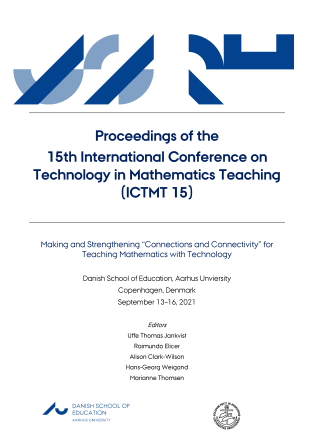Proceedings of the 15th International Conference on Technology in Mathematics Teaching: Making and Strengthening "Connections and Connectivity" for Teaching Mathematics with Technology

Editors
Synopsis
The 15th International Conference on Technology in Mathematics Teaching (ICTMT 15) took place on September 13–16, 2022, in the Danish School of Education, Aarhus University, located on campus Emdrup, in the Northwestern district of Copenhagen, Denmark. There were a total of 66 participants from 15 different countries.
ICTMT 15 certainly focused on the impacts that the coronavirus pandemic has had on global mathematics education. However, it looked at the impacts of digital technology from a much wider perspective. In particular, the conference aimed to highlight how technology facilitates the multiple “Connections and Connectivity” between us all to achieve the goals of purposeful mathematics education in the early 21st century.
By “Connections” we mean the interrelationships between researchers, teachers, students, parents, policymakers, and industry (big and small). “Connectivity” includes oral, aural, textual and gestural communications as mediated by the internet, learning environments and classroom activities. Together, “Connections and Connectivity” describes the relationships between people, between different ideas and strategies to teach, and between people and environments. It offers a frame through which to interpret assessment in mathematics education as a more formative process from the point of view of both teachers and students.
Chapters
-
Introduction to the Proceedings of ICTMT 15
-
Embedding Mathematics in Socio-Scientific GamesThe Case of the Mathematical in Grappling with Wicked Problems
-
Metaphor-Based Algebra Animation
-
Digital Media as Tools Fostering Teacher Creativity on Designing Tasks Around an Area of Mathematical Concepts
-
Nature of the Relations between Programming and Computational Thinking and Mathematics in Danish Teaching Resources
-
Discovering the Possibilities of a Computer-Based Learning Environment for Mathematical Modelling
-
How About that Algebra View in GeoGebra? A Review on How Task design May Support Algebraic Reasoning in Lower Secondary School
-
Go Online to Go Outdoors – A MOOC on MathCityMap
-
Developing Silent Video Tasks' Instructional Sequence in Collaboration with Teachers
-
Synchronous Distance Learning with MCM@home: A Case Study on Digital Learning Environments
-
Writing Atomic, Reusable Feedback to Assess Handwritten Math Tasks Semi-Automatedly
-
Relational Thinking Supported by an Algebraic Modeling Tool on the Web
-
"... Then It Looks Beautiful" – Preformal Proving in Primary School
-
Forms of Epistemic Feedback
-
Challenges of Procedure-Oriented Cognitive Conflict Strategies for Undergraduate Students
-
Shifts from Teaching Mathematics with Technology to Teaching Mathematics through Technology: A Focus on Mathematical Discussion
-
Does the Gender Matter? The Use of a Digital Textbook Compared to Printed Materials
-
Mathematical Thinking And Social Construction of Meanings in Distance Contexts: The Role of the Teacher
-
Children in Movement Towards STEAM: Coding and Shapes at Kindergarten
-
Spatial and Computational Thinking at Kindergarten through the Aid of an Educational Robot
-
A Review on Allgemeinbildung and Mathematical Literacy in Relation to Digital Technologies in Mathematics Education
-
Teacher Development in Computational Thinking and Student Performance in Mathematics: A Proxy-Based TIMSS Study
-
The Use of Digital Technologies for Mathematical Thinking Competency
-
Graphing Calculator in the Connection between Geometry and Functions with the Contribution of Semiotic Mediation
-
Finding Theorems and Their Proofs by Using a Calculator with CAS in University-Level Mathematics
-
Mathematical Thinking in the Interplay Between Historical Original Sources and GeoGebra
-
An Examination of Preservice Mathematics Teachers’ Experiences at an Online Laboratory School
-
A Videogame as a Tool to Orchestrate Productive Mathematical Discussions
-
Te(a)ching to Collaborate: Automatic Assessment-Based Grouping Recommendations and Implications for Teaching
-
When a Digital Tool Guides Mathematical Communication
-
Connectivity Related Issues in a Modularised Course Involving Mathematics
-
The Purpose of Handwriting with Tablet-Computers and Smartpens in Mathematical Group Work over Distance
-
Affordances of University-Based Online Laboratory School: Types of Feedback
-
Examining Heuristic Worked Example Videos in a Collaborative Setting: The Conception of the Project MoVie
-
An Interactive Digital Environment for Teaching and Learning Deductive Geometry (FullProof): Design Principles, Functionality, Pedagogy and Implementation Results
-
Understanding Linear Functions in an Interactive Digital Learning Environment
-
Virtual Reality in Mathematics Education: Design of an Application for Multiview Projections
-
Mixed Reality in Mathematics Education
-
Designing Tasks and Feedback Utilizing a Combination of a Dynamic Mathematics Software and a Computer-Aided Assessment System
-
Teaching Machine Learning with Decision Trees in Middle School Using CODAP
-
Successful Modeling Processes in a Computer-Based Learning Environment
-
SMARTA—Online-Diagnostic to Reveal Students’ Algebraic Thinking and Enhance Teachers’ Diagnostic Competencies
-
Comparing Programming and Computational Thinking with Mathematical Digital Competencies from an Implementation Perspective
-
MCM@home: An Approach for Synchronous Distance Learning with Mobile Devices
-
An Approach to Teaching Data Science in Middle School

